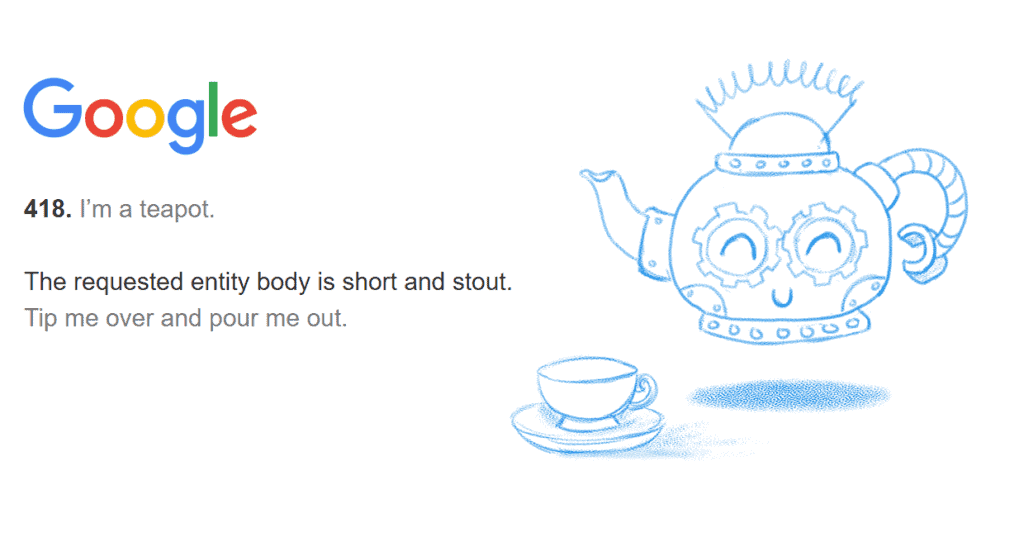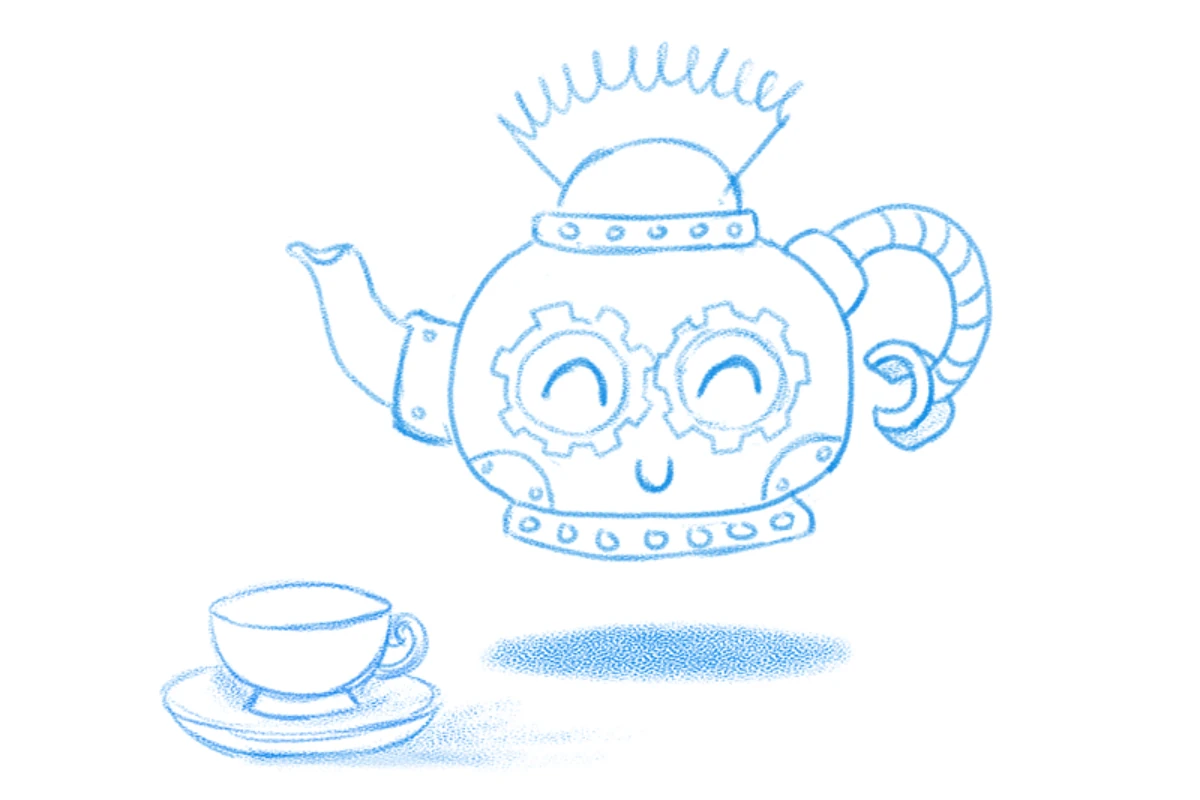The 418 status code, famously known as “I’m a Teapot,” stands out among various HTTP response codes due to its unusual nature. It comes from an April Fools’ joke published in 1998 as part of the Hyper Text Coffee Pot Control Protocol (HTCPCP) and is not intended to be used in actual HTTP communications. Despite its humorous origins, the 418 error code has captured the attention of developers and has been preserved over time. The server error basically states that you attempted to perform an action that a teapot is incapable of, namely brewing coffee.
Want to check it out for yourself, try Google’s page here: https://www.google.com/teapot
Error: 418 Status Code Explained
| Feature | Description |
|---|---|
| Code | 418 |
| Meaning | “I’m a teapot” |
| Category | Client Error (4xx) |
| Origin | Humorous reference in the Hyper Text Coffee Pot Control Protocol (HTCPCP) (RFC 2324, an April Fool’s joke) |
| Usage | Not a common error, but some servers may use it for specific situations like refusing unsupported requests |
| Purpose | To indicate the server cannot fulfill a certain request in a lighthearted way |
| Example Message | “418 I’m a teapot” |

Although this code is largely an Easter egg within the developer community, its existence raises questions regarding the implementation and handling of HTTP status codes. Being aware of the 418 status code’s place within the broader spectrum of HTTP responses is useful for understanding the full scope of HTTP and the creativity of the programming world. While you’re unlikely to encounter it in standard web development practices, it is a reminder of the whimsical elements that can exist in technology standards.
Key Takeaways
- The 418 status code is a humorous error originating from the HTCPCP.
- It indicates a client has made a request from a teapot to brew coffee.
- While mostly an Easter egg, it reflects the breadth of HTTP status codes.
Understanding the 418 I’m a Teapot Error
In this section, we discuss the quirky 418 I’m a Teapot error code with its origins, technical background, and how it’s used today as a fun Easter egg in web development.
Origins and History
Originally documented in RFC 2324 as an April Fools’ prank, the 418 I’m a Teapot status code was published in 1998 by the IETF. Its creation formed part of the Hyper Text Coffee Pot Control Protocol, a humorous protocol that was never intended for actual implementation. Despite this, 418 has since become a memorable part of web culture.
Technical Explanation
When a server refuses a client’s request to brew coffee, it responds with error code 418, which indicates the machine is a teapot. As a Client Error Response Code, this signifies that the client’s request was understood, but the server will not fulfill it due to its nature as a teapot, a device meant to brew tea, not coffee.
Current Usage and Easter Eggs
Over the years, the 418 status code has been playfully implemented by various websites as an Easter egg. It serves no technical purpose but remains in the HTTP status code index, often used by developers to inject a bit of levity into the error handling process of applications and APIs.
Handling and Implementing 418 Response
The 418 Status Code, also known as “I’m a Teapot”, is a unique HTTP client error status response. Appropriate implementation and handling in web applications are vital for consistent behavior across platforms.
Correct Use in Applications
418 I’m a Teapot should be implemented in web services as an easter egg or playful error message. In languages like Python, .Net, or frameworks like Angular or Symfony, a developer can handle 418 explicitly by using status code libraries (like HTTP::StatusCode::ImATeapot in Rust or @Angular/Common/Http/HttpStatuscode.Imateapot in Angular).
-
In Python:
from flask import Flask, Response app = Flask(__name__) @app.route('/teapot') def teapot(): return Response("I'm a teapot", status=418) -
In .NET:
using Microsoft.AspNetCore.Mvc; [ApiController] [Route("[controller]")] public class TeapotController : ControllerBase { [HttpGet] public IActionResult Get() { return StatusCode(418, "I'm a teapot"); } }
When an application encounters a scenario where a teapot is metaphorically asked to brew coffee, the server refuses the request by returning this response. This response indicates the server recognized the request but will not process it, in line with the RFC 2324 definition.
Client-Side Handling
On the client side, handling the error code entails recognizing it and providing users with clear feedback. Clients should not treat this as a typical error to troubleshoot but rather as a sign that they’ve reached a limit of an application’s functionality or encountered a non-standard response, often in response to automated queries.
- For instance, in Angular:
import { HttpClient, HttpErrorResponse } from '@angular/common/http'; constructor(private http: HttpClient) {} getTeapotResponse() { this.http.get('api/teapot').subscribe({ next: (data) => console.log(data), error: (error: HttpErrorResponse) => { if(error.status === 418) { alert("The server is a teapot, not a coffee maker!"); } } }); }
The 418 I’m a Teapot code serves as a reminder of the whimsical side of web development and is not meant for practical use in application logic. It can serve as a placeholder for custom server behavior not covered by standard HTTP codes.
Frequently Asked Questions
This section aims to clarify common inquiries surrounding the 418 HTTP status code and provide practical information for both users and developers.
What does the 418 HTTP status code represent?
The 418 HTTP status code means “I’m a teapot.” This response is a part of an April Fools’ joke from 1998 and indicates that the server refuses to brew coffee because it is, in fact, a teapot.
How can a ‘418 I’m a Teapot’ error be triggered?
This error can be triggered when a server is asked to perform an action it identifies as being akin to making coffee, as per the Hyper Text Coffee Pot Control Protocol (HTCPCP), which is a humorous protocol and not widely implemented.
Is the ‘418 I’m a Teapot’ status code a real HTTP response?
Yes, the ‘418 I’m a Teapot’ status code is a real HTTP response as defined in RFC 2324, though it was created as an April Fools’ joke and is not used in actual HTTP servers for legitimate errors.
Can the 418 error code affect website functionality?
No, the 418 error code should not affect website functionality as it is not intended for actual use. If a website ever presents a 418 error, it is likely an intentional easter egg or joke.
How should developers handle receiving a 418 status code in an application?
Developers encountering a 418 status code should consider it a non-standard and humorous response. They should verify the server’s response handling to ensure no actual issues are causing unexpected errors.
What are the practical applications of the 418 status code?
There are no practical applications for the 418 status code in real-world HTTP communication. It exists primarily as a novelty and is used to inject humor into discussions about HTTP status codes.





